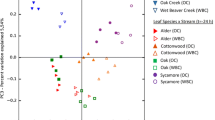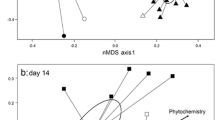Abstract
We investigated how a community of microbial decomposers adapted to a reference site responds to a sudden decrease in the water quality. For that, we assessed the activity and diversity of fungi and bacteria on decomposing leaves that were transplanted from a reference (E1) to a polluted site (E2), and results were compared to those from decomposing leaves either at E1 or E2. The two sites had contrasting concentrations of organic and inorganic nutrients and heavy metals in the stream water. At E2, leaf decomposition rates, fungal biomass, and sporulation were reduced, while bacterial biomass was stimulated. Fungal diversity was four times lower at the polluted site. The structure of fungal community on leaves decomposing at E2 significantly differed from that decomposing at E1, as indicated by the principal response curves analysis. Articulospora tetracladia, Anguillospora filiformis, and Lunulospora curvula were dominant species on leaves decomposing at E1 and were the most negatively affected by the transfer to the polluted site. The transfer of leaves colonized at the reference site to the polluted site reduced fungal diversity and sporulation but not fungal biomass and leaf decomposition. Overall, results suggest that the high diversity on leaves from the upstream site might have mitigated the impact of anthropogenic stress on microbial decomposition of leaves transplanted to the polluted site.





Similar content being viewed by others
References
APHA (1998) Standard methods for the examination of water and wastewater, 20th edn. American Public Health Association, Washington, DC
Baldy V, Chauvet E, Charcosset J-Y, Gessner MO (2002) Microbial dynamics associated with leaves decomposing in the mainstem and floodplain pond of a large river. Aquat Microb Ecol 28:25–36
Baldy V, Gobert V, Guerold F, Chauvet E, Lambrigot D, Charcosset J-Y (2007) Leaf litter breakdown budgets in streams of various trophic status: effects of dissolved inorganic nutrients on microorganisms and invertebrates. Freshwat Biol 52:1322–1335
Bärlocher F (2005) Freshwater fungal communities. In: Deighton J, White JF Jr, Oudemans P (eds) The fungal community: its organization and role in the ecosystem, 3rd edn. Taylor and Francis, CRC, Boca Raton, Florida, pp 39–59
Bärlocher F, Canhoto C, Graça MAS (1995) Fungal colonization of alder and eucalypt leaves in two streams in central Portugal. Arch Hydrobiol 133:457–470
Bratbak G (1993) Microscope methods for measuring bacterial biovolume: epifluorescence microscopy, scanning electron microscopy, and transmission electron microscopy. In: Kemp PF, Sherr BF, Sherr EB, Cole JJ (eds) Handbook of methods in aquatic microbial ecology. Lewis, Boca Raton, Florida, pp 309–317
Cardinale BJ, Ives AR, Inchausti P (2004) Effects of species diversity on the primary productivity of ecosystems: extending our spatial and temporal scales of inference. Oikos 104:437–450
Cardinale BJ, Palmer MA, Collins SL (2002) Species diversity enhances ecosystem functioning through interspecific facilitation. Nature 415:429
Chauvet E, Fabre E, Elósegui A, Pozo J (1997) The impact of eucalypt on the leaf associated aquatic hyphomycetes in Spanish streams. Can J Bot 75:880–887
Covich AP, Austen MC, Bärlocher F, Chauvet E, Cardinale BJ, Biles CL, Inchausti P, Dangles O, Solan M, Gessner MO, Statzner B, Moss B (2004) The role of biodiversity in the freshwater and marine benthic ecosystems. BioScience 54:767–775
Dang CK, Chauvet E, Gessner MO (2005) Magnitude and variability of process rates in fungal diversity-litter decomposition relationships. Ecol Lett 8:1129–1137
Duarte S, Pascoal C, Alves A, Correia A, Cássio F (2008) Copper and zinc mixtures induce shifts in microbial communities and reduce leaf litter decomposition in streams. Freshwat Biol 53:91–101
Duarte S, Pascoal C, Cássio F (2004) Effects of zinc on leaf decomposition in streams: studies in microcosms. Microb Ecol 48:366–374
Duarte S, Pascoal C, Cássio F, Bärlocher F (2006) Aquatic hyphomycete diversity and identity affect leaf litter decomposition in microcosms. Oecologia 147:658–666
Dudgeon D, Arthington AH, Gessner MO, Kawabata Z-I, Knowler DJ, Lévêque C, Naiman RJ, Prieur-Richard A-H, Soto D, Stiassny MLJ, Sullivan CA (2006) Freshwater biodiversity: importance, threats, status and conservation challenges. Biol Rev 81:163–182
Emmerson MC, Solan M, Emes C, Paterson DM, Raffaelli D (2001) Consistent patterns and the idiosyncratic effects of biodiversity in marine ecosystems. Nature 411:73–77
Ferreira V, Gulis V, Graça MAS (2006) Whole-stream nitrate addition affects litter decomposition and associated fungi but not invertebrates. Oecologia 149:718–729
Gessner MO (2005) Ergosterol as a measure of fungal biomass. In: Graça MAS, Bärlocher F, Gessner MO (eds) Methods to study litter decomposition: a practical guide. Springer, Berlin, pp 171–176
Gessner MO, Chauvet E (1993) Ergosterol-to-biomass conversion factors for aquatic hyphomycetes. Appl Environ Microbiol 59:502–507
Giller PS, Hillebrand H, Berninger U-G, Gessner MO, Hawkins S, Inchausti P, Inglis C, Leslie H, Malmqvist B, Monaghan MT, Morin PJ, O’Mullan G (2004) Biodiversity effects on ecosystem functioning: emerging issues and their experimental test in aquatic environments. Oikos 104:423–436
Gulis V, Ferreira V, Graça MAS (2006) Stimulation of leaf litter decomposition and associated fungi and invertebrates by moderate eutrophication: implications for stream assessment. Freshwat Biol 51:1655–1669
Gulis V, Suberkropp K (2003) Effect of inorganic nutrients on relative contributions of fungi and bacteria to carbon flow from submerged decomposing leaf litter. Microb Ecol 45:11–19
Gulis V, Suberkropp K (2003) Leaf litter decomposition and microbial activity in nutrient-enriched and unaltered reaches of a headwater stream. Freshwat Biol 48:123–134
Hieber M, Gessner MO (2002) Contribution of stream detritivores, fungi, and bacteria to leaf breakdown based on biomass estimates. Ecology 83:1026–1038
Hooper DU, Chapin FS III, Ewel JJ, Hector A, Inchausti P, Lavorel S, Lawton JH, Lodge DM, Loreau M, Naeem S, Schmid B, Setälä H, Symstad AJ, Vandermeer J, Wardle DA (2005) Effects of biodiversity on ecosystem functioning: a consensus of current knowledge. Ecol Monogr 75:3–35
Jonsson M, Malmqvist B (2000) Ecosystem process rate increases with animal species richness: evidence from leaf-eating aquatic insects. Oikos 89:519–523
Lecerf A, Usseglio-Polatera P, Charcosset J-Y, Lambrigot D, Bracht B, Chauvet E (2006) Assessment of functional integrity of eutrophic streams using litter breakdown and benthic macroinvertebrates. Arch Hydrobiol 165:105–126
Legendre P, Legendre L (1998) Numerical Ecology. Developments in environmental modeling, 20, 2nd edn. Elsevier, Amsterdam
Loreau M, Mouquet N, Gonzalez A (2003) Biodiversity as spatial insurance in heterogeneous landscapes. Proc Nat Acad Sci USA 22:12765–12770
Loreau M, Naeem S, Inchausti P (eds) (2002) Biodiversity and Ecosystem functioning: synthesis and perspectives. Oxford University Press, New York
McGrady-Steed J, Harris PM, Morin PJ (1997) Biodiversity regulates ecosystem predictability. Nature 390:162–165
Mesquita A, Pascoal C, Cássio F (2007) Assessing effects of eutrophication in streams based on breakdown of eucalypt leaves. Arch Hydrobiol 168:221–230
Niyogi DK, Lewis WM Jr, McKnight DM (2001) Litter breakdown in mountain streams affected by mine drainage: biotic mediation of abiotic factors. Ecol Appl 11:506–516
Niyogi DK, Lewis WM Jr, McKnight DM (2002) Effects of stress from mine drainage on diversity, biomass, and function of primary producers in mountain streams. Ecosystems 5:554–567
Niyogi DK, McKnight DM, Lewis WM Jr (2002) Fungal communities and biomass in mountain streams affected by mine drainage. Arch Hydrobiol 155:255–271
Norberg J (2004) Biodiversity and ecosystem functioning: a complex adaptive systems approach. Limnol Oceanogr 49:1269–1277
Pardal MA, Cardoso PG, Sousa JP, Marques JC, Raffaelli D (2004) Assessing environmental quality: a novel approach. Mar Ecol Prog Ser 267:1–8
Pascoal C, Cássio F (2004) Contribution of fungi and bacteria to leaf litter decomposition in a polluted river. Appl Environ Microbiol 70:5266–5273
Pascoal C, Cássio F, Gomes P (2001) Leaf breakdown rates: a measure of water quality? Int Rev Hydrobiol 86:407–416
Pascoal C, Cássio F, Marvanová L (2005) Anthropogenic stress may affect aquatic hyphomycete diversity more than leaf decomposition in a low order stream. Arch Hydrobiol 162:481–496
Pascoal C, Marvanová L, Cássio F (2005) Aquatic hyphomycete diversity in streams of Northwest Portugal. Fungal Divers 19:109–128
Pascoal C, Pinho M, Cássio F, Gomes P (2003) Assessing structural and functional ecosystem using leaf breakdown: studies on a polluted river. Freshwat Biol 48:2033–2044
Raviraja NS, Sridhar KR, Bärlocher F (1998) Breakdown of Ficus and Eucalyptus leaves in an organically polluted river in India: fungal diversity and ecological functions. Freshwat Biol 39:537–545
Simon M, Azam F (1989) Protein content and protein synthesis rate of planktonic marine bacteria. Mar Ecol Prog Ser 51:201–213
Sridhar KR, Bärlocher F, Krauss G-J, Krauss G (2005) Response of aquatic hyphomycete communities to changes in heavy metal exposure. Internat Rev Hydrobiol 90:21–32
Sridhar KR, Krauss G, Bärlocher F, Raviraja NS, Wennrich R, Baumbach R, Krauss G-J (2001) Decomposition of alder leaves in two heavy metal-polluted streams in central Germany. Aquat Microb Ecol 26:73–80
Suberkropp K (1998) Microorganisms and organic matter decomposition. In: Naiman RJ, Bilby RE (eds) River ecology and management: lessons from the Pacific coastal ecoregion. Springer, New York, pp 120–143
Suberkropp K, Chauvet E (1995) Regulation of leaf breakdown by fungi in streams: influences of water chemistry. Ecology 76:1433–1445
Van den Brink PJ, Ter Braak CJF (1999) Principal response curves: analysis of time-dependent multivariate responses of a biological community to stress. Environ Toxicol Chem 18:138–148
Walker BH (1992) Biodiversity and ecological redundancy. Biol Conserv 6:18–23
Yachi S, Loreau M (1999) Biodiversity and ecosystem productivity in a fluctuating environment: the insurance hypothesis. Proc Natl Acad Sci USA 96:1463–1468
Zar JH (1996) Biostatistical analysis, 3rd edn. Prentice-Hall, Englewood Cliffs, New Jersey
Acknowledgments
The Portuguese Foundation for the Science and the Technology supported S. Duarte (SFRH/BD/13482/2003). The authors are grateful to D. Duarte and L. Soares for field assistance.
Author information
Authors and Affiliations
Corresponding author
Rights and permissions
About this article
Cite this article
Duarte, S., Pascoal, C. & Cássio, F. High Diversity of Fungi may Mitigate the Impact of Pollution on Plant Litter Decomposition in Streams. Microb Ecol 56, 688–695 (2008). https://doi.org/10.1007/s00248-008-9388-5
Received:
Revised:
Accepted:
Published:
Issue Date:
DOI: https://doi.org/10.1007/s00248-008-9388-5




